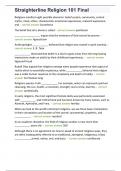Straighterline Religion 101 Final
Religions manifest eight possible elements: belief system, community, central
myths, ritual, ethics, characteristic emotional experiences, material expression,
and - correct answer Sacredness
The belief that all is divine is called - correct answer pantheism
__________________ argues that the existence of God cannot be proven. -
correct answer Agnosticism
Anthropologist ___________ believed that religion was rooted in spirit worship. -
correct answer E. B. Tylor
___________ theorized that belief in a God or gods arises from the long-lasting
impressions made on adults by their childhood experiences. - correct answer
Sigmund Freud
Rudolf Otto argued that religions emerge when people experience that aspect of
reality which is essentially mysterious; while ___________ believed that religion
was a noble human response to the complexity and depth of reality. - correct
answer Carl Gustav Jung
Religions express truth ___________. For example, water can represent spiritual
cleansing; the sun, health; a mountain, strength; and a circle, eternity. - correct
answer symbolically
In early religions, the most significant female deity was particularly associated
with ___________ and motherhood and has been known by many names, such as
Asherah, Aphrodite, and Freia. - correct answer fertility
When we look at the world's dominant religions, we see three basic orientations
in their conceptions and location of the sacred: sacramental, prophetic, and
___________. - correct answer mystical
As an academic discipline, the field of religious studies is now more than
___________ years old. - correct answer 200
Although there is no agreement on how to speak of ancient religious ways, they
are often inadequately referred to as traditional, aboriginal, indigenous, tribal,
___________, primal, native, oral, and basic. - correct answer nonliterate
,Straighterline Religion 101 Final
Indigenous religions exist generally within ___________ cultures, in which every
object and act may have religious meaning. - correct answer holistic
In many Native American religious traditions, there is little distinction between
the human and animal worlds. These native religions see everything in the
universe as being alive, a concept known as ___________. - correct answer
animism
Sacred time is "the time of ___________." Among the Koyukon people of the
Arctic, it is called "distant time," and it is the holy ancient past in which gods lived
and worked. Among Australian Aborigines it is often called Dreamtime, and it is
the subject of much of their highly esteemed art. - correct answer eternity
___________ is the doorway through which the "other world" of gods and
ancestors can contact us and we can contact them. It is associated with the center
of the universe and can be constructed, often in a symbolic shape such as a circle
or square. - correct answer Sacred space
Most indigenous religions have cosmic tales of their ___________. They
frequently speak of a High God and make little distinction between a god and an
ancestor. - correct answer origins
In native societies, everyday religious activity and practice are significant, because
their primary purpose is often to place individuals, families, and groups in "right
___________" with gods, ancestors, other human beings, and nature. - correct
answer relationships
Special rituals mark a person's entry into adulthood. In Native American religions,
a common ritual of early maturity is the "vision quest," or "___________." -
correct answer dream quest
A ___________ is a rule that forbids specific behavior with regard to certain
objects, people, animals, days, or phases of life. - correct answer taboo
A(n) ___________ acts as an intermediary between the visible, ordinary world
and the spirit world. - correct answer shaman
The culture that flourished in the Indus River valley before 2000 bce is named the
___________ culture. - correct answer Harappa
, Straighterline Religion 101 Final
The ancient scriptures of India are called the ___________. There are four basic
text collections: the Rig, the Yajur, the Sama, and the Atharva. - correct answer
Vedas
round 500 bce, Indian civilization experienced such widespread and important
changes that the period is called the ___________ Age. - correct answer Axis
In the Upanishads, the term ___________ refers to the experience of the sacred
within nature and the external universe, while ___________ refers to the
experience of the sacred within oneself. Both terms may be used interchangeably.
- correct answer Brahman; Atman
The ___________ is part of a very long epic poem called the Mahabharata; it
recalls themes from the Upanishads. - correct answer Bhagavad Gita
Hinduism has a(n) ___________ system with five main social classes: brahmin
(priest), kshatriya (warrior-noble), vaishya (merchant), shudra (peasant), and dalit
(untouchable). - correct answer caste
The word yoga means "___________." - correct answer union
Shankara's belief that spiritual liberation was achieved when the individual
personally came to understand the unity of all things is called ___________. -
correct answer monism
When linked together, Brahma, Vishnu, and Shiva are often called the
___________. - correct answer Trimurti
Mohandas Gandhi's use of ___________ techniques, including marches, hunger
strikes, talks, demonstrations, and publicity, was adopted by Martin Luther King
Jr. to help protest racial segregation in the United States. - correct answer
nonviolent
Siddhartha's encounters with an old man, a sick man, a corpse, and a wandering
holy man, which prompted him to leave his luxurious and carefree life, are called
the ___________. - correct answer Four Passing Sights
After Siddhartha spent an entire night meditating under a full moon, he finally
achieved insight into release from suffering and rebirth. Buddhists believe that he




